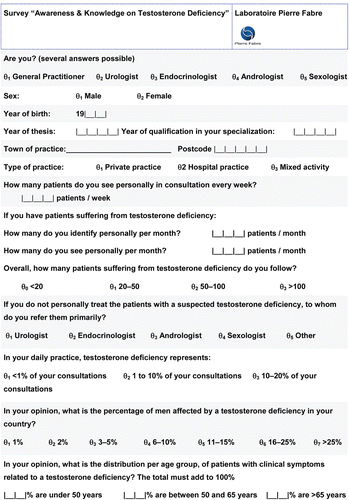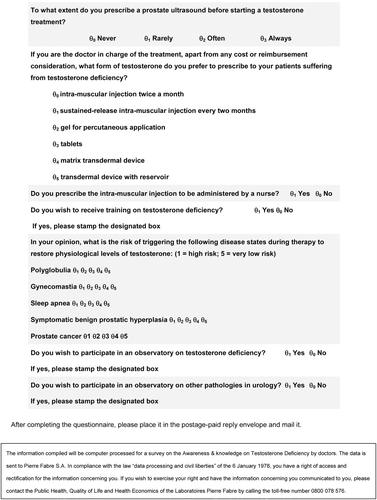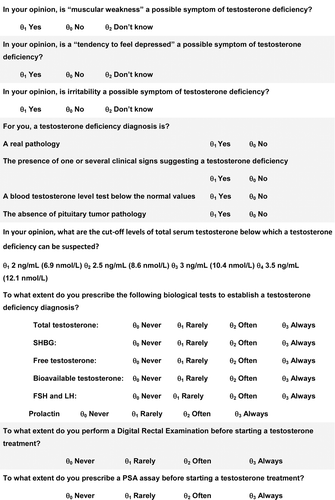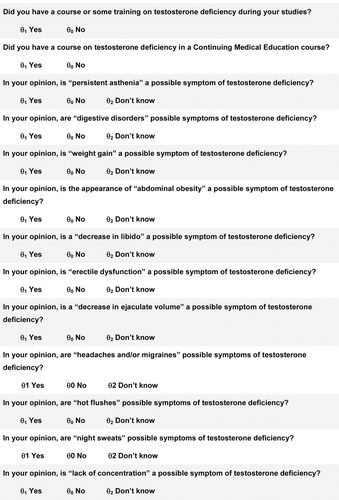Abstract
Background: Despite being one of the relevant public health threats among ageing men, testosterone deficiency syndrome (TDS) is under-recognized and under-diagnosed. Objective: To assess current clinical practices of European physicians regarding diagnosis and management of TDS compared with current guidelines. Methods: Postal survey conducted June–November 2008 in France, Germany, Italy and Spain among urologists, endocrinologists and general practitioners to collect information regarding knowledge of TDS. Results: Among 801 respondents, the majority of endocrinologists and urologists had received training on TDS, either initially or as part of continuous medical education. TDS was recognized by 86.5% of physicians as a true clinical entity, and estimated the prevalence at 10–15% of the male population; 73.5% considered that symptoms and a low level of testosterone were required for diagnosis. Treatment preferences were quarterly intramuscular injections (26.3% of physicians), percutaneous gels (23.9%), matrix patch (21.2%), semi-monthly injections (15.4%) and oral therapy (13.4%). Adverse effects of testosterone replacement therapy, such as benign prostatic hyperplasia and prostate cancer, were a concern for physicians. Conclusions: TDS management appeared to be close to that recommended in international guidelines. Signs and symptoms of testosterone deficiency were fairly well known, but some diagnostic and treatment variations were observed.
Introduction
Testosterone production decreases gradually with age [Citation1,Citation2]. Loss of muscle mass and strength, decrease in sexual function, increase in fat mass and depressed mood, may follow the gradual decline in serum testosterone level.
The role of testosterone and its involvement in metabolic illnesses is underestimated and testosterone deficiency syndrome (TDS) or late-onset hypogonadism (LOH) is under-recognized and under-diagnosed in ageing men. Low testosterone levels, which correlate with an increased death rate in men [Citation3,Citation4], are often associated with cardiovascular disease [Citation3], diabetes [Citation5] or other metabolic disorders in a very complex relationship [Citation6]. Emerging evidence suggests that testosterone may play an important role in the regulation of homeostasis of multiple organ systems and the co-existence of these conditions [Citation6–9].
Although TDS is common in ageing men, its prevalence is controversial. The overall prevalence in the general male population varies from study to study and may be as high as 15–30% in diabetic and obese men [Citation10,Citation11]. In a 2009 international review of demographic data, the average prevalence of TDS symptoms in men over 50 years was 20%; however, in most European countries, only 1% of men receive treatment [Citation12]. Findings from a recent large study conducted in a random European population of men aged 40–79 years suggested that TDS should be defined as the presence of at least three sexual symptoms (i.e. poor morning erection, low sexual desire and erectile dysfunction) and total and free testosterone levels of <11 nmol/L (3.2 ng/mL) and 220 pmol/L (64 pg/mL), respectively. Using these criteria, the prevalence of TDS in this population was 2.1%, rising up to 3.2% in men aged 60–69 years, and to 5.1% for those 70–79 years [Citation13].
In a UK screening audit in 124 men with erectile dysfunction, the incidences of metabolic syndrome and TDS were 40 and 27%, respectively, highlighting the importance of routine screening in such patients.
Given the increased longevity of the general population worldwide, the number of men with TDS will continue to increase. Nowadays, TDS is one of the relevant public health threats among ageing men, enhancing the need for better information and education of physicians and the male global population.
The aim of the Transversal European survey on testosterone deficiency diagnosis (TESTo-Dia) was to assess the current clinical practice of physicians in Europe in terms of diagnosis and management of TDS in ageing men, and to compare these findings with current consensus recommendations on the diagnosis and treatment of LOH developed jointly by the International Society of Andrology, the International Society for the Study of the Ageing Male, the European Association of Urology, the European Academy of Andrology and the American Society of Andrology [Citation14].
Methods
Methodology
This was a transversal, multicenter survey conducted between June and November 2008 in France, Germany, Italy and Spain. Targeted physicians included endocrinologists and urologists and a random sample of general practitioners (GPs).
A survey questionnaire () was mailed to every endocrinologist and urologist within each country, and to a random sample of 9000 GPs indexed in the European medical management and health network database. The questionnaire included the following items: medical background, type of practice, training on TDS, number of patients seen with TDS in current practice, clinical and biochemical diagnosis of TDS, treatment modalities and perceptions on adverse effects of testosterone replacement therapy.
Statistical analysis
Analysis of data was done using a descriptive method (mean and standard deviation for continuous data, frequency and percentages for categorical data). Analyses were conducted according to physician subgroup and/or by country. All percentages were calculated using the total number of responding physicians, whether they provided an answer to the individual question or not. Treatment preferences are presented as an integration of ranked maximal preferences.
Results
A total of 801 physicians participated in the survey: 192 endocrinologists (24.0%), 360 GPs (44.9%) and 249 urologists (31.1%). The return rate of the questionnaire was 0.5–4.0% across participating countries, except for France where the return rate was approximately 9.0%.
Physicians’ profile and practice
Among responding physicians, 623 were male (77.8%), 174 female (21.7%) and four (0.5%) did not give this information; more than 95.0% of urologists were male. Overall, 32.8% of physicians were aged 45–54 years and 32.6% were 55–64 years.
A total of 31.5% of physicians were working in private practice, 22.6% in a public structure and 14.1% in both, with a slightly higher proportion of endocrinologists working in public institutions (29.7%) than GPs or urologists.
The majority (65.2%) of participants had graduated more than 15 years ago. The mean number of patients seen in consultation per month was 460 ± 249 for GPs, 287 ± 194 for urologists and 241 ± 180 for endocrinologists, of whom 5.3, 17.3 and 9.5%, respectively, had been diagnosed by their physician as having TDS.
The majority of endocrinologists and urologists had received training on TDS, either during their initial medical education or as part of continuous medical education; training among GPs was relatively lower (). Compared with France and Spain, Italy and Germany had higher observed scores for TDS training.
Figure 2. Physicians’ responses “yes” to questions on training and continuous medical education. Question: Did you have a course or some training on testosterone deficiency during your initial medical education? 1) Yes; 2) No; Question: Did you have training on testosterone deficiency as part of a Continuing Medical Education course? 1) Yes; 2) No.
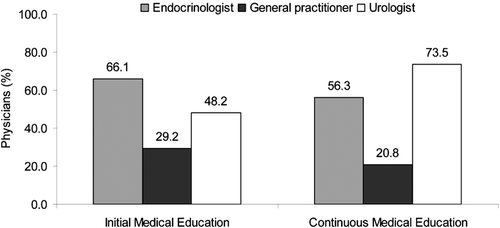
Opinions on TDS
A majority (57.4%) of physicians estimated the prevalence of TDS as 10–15% of the male population in their respective country. The prevalence in patients stratified by age was evaluated to be 14.9 ± 13.3% for patients younger than 50 years, 31.9 ± 15.5% for patients 50–65 years and 51.0 ± 20.6% for patients elder than 65 years.
TDS was recognized by 86.5% of physicians as a true clinical entity, and most (73.5%) considered that both symptoms and low testosterone levels were required for a diagnosis of TDS, ranging from 65.6% for GPs and 76.6% for endocrinologists to 82.7% for urologists. Most GPs (76.9%) referred any suspected TDS patients to a specialist, which included an endocrinologist (35.0%) or urologist (26.4%). The signs and symptoms most recognized as being related to TDS are shown in , and the most preferred cut-off value for total testosterone below which TDS is diagnosed was 2.5 ng/mL (8.6 nmol/L) for GPs and urologists, and 3.0 ng/mL (10.4 nmol/L) for endocrinologists (). The highest cut-off value of 3.5 ng/mL (12.1 nmol/L) was used by only 9.6% of respondents.
Table I. Percentage of responding physicians (n = 801) agreeing to signs and symptoms of testosterone deficiency syndrome.
With a global rate of 80.3%, total testosterone was the most common laboratory assay used to complete the diagnosis of TDS when total testosterone was low in the first blood sample. This was followed by follicle-stimulating hormone (FSH) and luteinizing hormone (LH) (67.0%) and prolactin assays (65.2%) (). The majority of tests were more frequently requested by urologists and endocrinologists, except for free testosterone that was requested more frequently by GPs.
Prostate-specific assessments included prostate-specific antigen (90.8%), digital rectal examination (77.2%) and ultrasound (70.4%).
Figure 3. Physicians’ responses to questions regarding testosterone cut-off values. Question: In your opinion, what are the cut-off levels of total serum testosterone below which a testosterone deficiency can be suspected? 1) 2 ng/mL (6.9 nmol/L); 2) 2.5 ng/mL (8.6 nmol/L); 3 ng/mL (10.4 nmol/L); 4) 3.5 ng/mL (12.1 nmol/L).
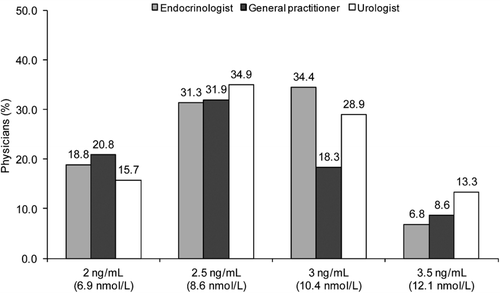
Figure 4. Physicians’ responses “Often/Always” to questions regarding laboratory assays used. Question: To what extent do you request the following laboratory tests to establish a testosterone deficiency diagnosis? 1) Total testosterone; 2) Free testosterone; 3) Bioavailable testosterone; 4) sex hormone-binding globulin (SHBG); 5) follicle-stimulating hormone (FSH) and luteinizing hormone (LH); 6) Prolactin. Never/Rarely/Often/Always.
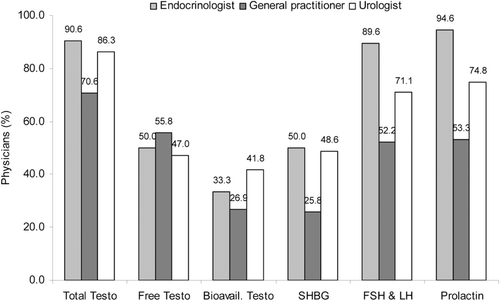
Treatment of TDS
Preferred testosterone treatment modalities, regardless of any economical consideration, were quarterly intramuscular injections (26.3%), percutaneous gels (23.9%), matrix transdermal device (21.2%), semi-monthly injections (15.4%) and oral therapy (13.4%). Urologists were more likely to prescribe percutaneous gel (). Overall, quarterly injections, gel and matrix patch are well accepted.
Adverse effects of testosterone treatment were an important concern, with benign prostatic hyperplasia considered the most likely adverse event (a risk score of 1 or 2 awarded by 37.5% of physicians), along with prostate cancer (35.3%), polycythemia (30.0%), gynecomastia (22.5%) and sleep apnea syndrome (13.6%) (). Individual risk scores awarded by physicians for the perceived risk of prostate cancer are shown in . Generally, GPs perceived the risk of prostate cancer as being higher than endocrinologists or urologists; more GPs believed there was a high risk of prostate cancer (risk score of 1) than endocrinologists or urologists (16.7% vs. 7.3% and 11.2%, respectively).
Figure 5. Physicians’ responses to questions regarding treatment preferences. Question: If you are the doctor in charge of the treatment, apart from any cost or reimbursement consideration, what form of testosterone do you prefer to prescribe to your patients suffering from testosterone deficiency? 1) intra-muscular injection twice a month; 2) intra-muscular injection every three months; 3) matrix transdermal device; 4) gel for percutaneous application; 5) tablets. As the data represent an integration of ranked maximal preferences, they do not exactly total 100%.
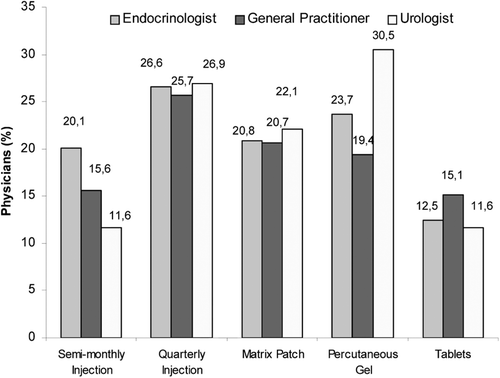
Figure 6. Physicians’ responses “1/2” to questions regarding potential adverse effects. Question: In your opinion, what is the risk of triggering the following disease states during therapy to restore physiological levels of testosterone: (1 = high risk; 5 = very low risk)? 1) polycythemia; 2) gynecomastia; 3) sleep apnea; 4) symptomatic benign prostatic hyperplasia (BPH); 5) prostate cancer.
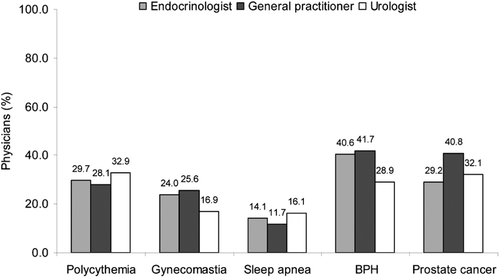
Table II. Physicians’ perceived risks of prostate cancer associated with testosterone replacement therapy.
Discussion
This multinational European survey provides a wide range of physicians’ opinions on current knowledge and practice on TDS, illustrating the daily practice of 801 experienced European specialists and primary care physicians. There are very few surveys on this topic [Citation15,Citation16].
While the concept of TDS had remained unclear for many years, most of the physicians in this survey (86.5%) now recognize TDS as a true clinical entity, with 73.5% using the criteria of symptoms plus low testosterone levels for TDS diagnosis, despite a lack of training on the disease across all countries.
The number of patients seen in practice was in contrast to the higher prevalence perceived by the majority of physicians, which may be explained by the clinical polymorphism of TDS, and an estimated prevalence of 2.1% in a recent study in European men [Citation13]. Variations in clinical presentation are dependent on testosterone levels and patient age, with signs and symptoms only becoming evident after testosterone levels drop below a threshold value that varies from one individual to another [Citation17]. Sexual symptoms were more easily recognized. The majority of physicians agreed on the conventional combination of symptoms and biochemical evidence of low testosterone levels to define TDS. This is consistent with International guidelines, which define TDS as a clinical and biochemical syndrome associated with advancing age, characterized by the association of symptoms and low serum testosterone levels [Citation14].
According to recommendations [Citation14], the biochemical diagnosis of TDS should be based on morning total testosterone or, when inconclusive, morning free testosterone; because of intra-subject variability, repeat confirmatory testing is warranted [Citation18]. In this survey, the majority of the physicians always used total testosterone in forming a diagnosis, with a third always using free testosterone measurement. Although the specific assay methods used in local laboratories was not captured in the survey, calculated free and/or bioavailable testosterone values [Citation19] were infrequently used. Urologists were less likely than endocrinologists to request FSH and LH assays, which may be explained by them being less aware of the clinical relevance and utility of FSH/LH.
No consensus on a clear cut-off point value of total testosterone level was reached. However, the majority of physicians used a threshold value of 2.5 ng/mL (8.6 nmol/L), a very stringent level given the inconsistencies in laboratory analyses and the individual degree of responsiveness to androgens [Citation12]. Endocrinologists and urologists tended to use a higher value of 3 ng/mL (10.4 nmol/L). There are no accepted testosterone limits for a biochemical diagnosis of TDS [Citation14,Citation20]; however, there is general agreement that patients with serum total or free testosterone levels <8 nmol/L (2.3 ng/mL) and 225 pmol/L (<65 pg/mL), respectively, usually require testosterone therapy, while those with levels >12 nmol/L (3.5 ng/mL) and >250 pmol/L (72 pg/mL), respectively, do not [Citation14,Citation20]. Between these levels, treatment can be considered if a complete biochemical work-up remains inconclusive in patients who show no alternative cause to their symptoms.
These cut-off values are supported by findings from a recent European survey [Citation13]. Researchers examined the association between TDS symptoms and testosterone levels in a sample of 3369 men from the general population aged 40–79 years [Citation13]. Sexual symptoms and decreased vigorous activity were significantly associated with low testosterone levels. Individual thresholds were observed for total testosterone levels below which there was a decreased frequency of sexual thoughts (8 nmol/L), erectile dysfunction (8.5 nmol/L), decreased frequency of morning erections (11 nmol/L) and diminished vigor (13 nmol/L). The free testosterone thresholds for these three sexual symptoms were 160, 280 and 280 pmol/L, respectively [Citation13]. Thus, there is not a clear-cut threshold; rather symptoms accumulate gradually with decreasing testosterone levels [Citation17]. From these data, Wu et al. [Citation13] determined that the minimum criteria for diagnosis of TDS should be the presence of at least three sexual symptoms associated with total testosterone <11 nmol/L and free testosterone <220 pmol/L.
Today, multiple options for treating TDS patients are available, including short- or long-acting intramuscular injections, transdermal applications and oral preparations of testosterone. Despite limited data from controlled trials, these treatments have shown to be safe and effective. However, only 0.69% of men over 50 years (those expected to be more likely to have TDS symptoms) are receiving testosterone treatment in most of European countries, whereas this figure is higher in Australia and the USA (1.64 and 7.96%, respectively) [Citation12].
The causes of failure to treat more patients with TDS could be explained not only by the lack of training on the diagnosis of TDS in ageing men, but also by the fear of potential side effects with testosterone treatment, especially in relation to prostate disease. In this survey, 58.2% (n = 466) of the physicians were concerned about a potential risk of inducing prostate cancer, a percentage similar to the one reported from a worldwide panel of 353 physicians [Citation15]. This fear was based on previous historical experiences reported in the literature [Citation21,Citation22] and was observed more in GPs and endocrinologists than urologists. Albeit testosterone treatment remains contraindicated in men with prostate cancer, current data does not support the hypothesis that endogenous testosterone or testosterone treatment induce prostate cancer in men [Citation23,Citation24].
Although not unusual for a postal survey, the low questionnaire return rate was a potential source of enrolment bias. One can expect that only physicians already interested in TDS accepted to participate, and the higher return rate in France may be related to a recent survey conducted by the French Association of Urology [Citation16]. The large acceptance by participants to receive survey results and be involved in an observatory on TDS appears to confirm this limitation.
Conclusions
This survey allowed a comparison among specialties from four European countries regarding various aspects of TDS, a relevant healthcare issue in ageing men. The knowledge and interest in TDS of physicians that returned the questionnaire were quite high. Although most of them had not been provided with training on TDS during their initial medical education, the daily practice in these four European countries comes close to the international recommendations. Overall, signs and symptoms suggestive of testosterone deficiency were fairly well known, while no consensus on total testosterone cut-off values and necessary hormone assays became evident, and the preferred use of testosterone preparations was different between medical specialties. Prostate cancer and benign prostatic hyperplasia still remain a significant concern not to treat testosterone-deficient patients for a majority of physicians.
Acknowledgements
We thank all the members of the scientific committee involved in this study, including European Coordinator Pr Jacques Tostain, French coordinators Pr Stéphane Droupy, Pr Sophie Christin-Maître and Dr Philippe Igigabel, Italian coordinators Pr Gentille, Pr Andrea Lenzi and Pr Vincenzo Mirone, German coordinators Dr Thomas Kreutzig and Pr Hermann Behre, and Spanish coordinators Dr Antonio Martin Morales, Dr Rafael Prieto Castro and Dr Ana Puigvert Martínez.
Declaration of Interest: This work was supported by a grant from Pierre Fabre Medicament. Also, medical writing support was provided by Mary Hines and Andrea Bothwell of in Science Communications, a Wolters Kluwer business, with funding from Pierre Fabre Medicament. H.M. Behre, S. Christin-Maître, A. Martin Morales and J. Tostain have received honoraria from Pierre Fabre Medicament.
References
- Feldman HA, Longcope C, Derby CA, Johannes CB, Araujo AB, Coviello AD, Bremner WJ, McKinlay JB. Age trends in the level of serum testosterone and other hormones in middle-aged men: longitudinal results from the Massachusetts male aging study. J Clin Endocrinol Metab 2002;87:589–598.
- Kaufman JM, Vermeulen A. Declining gonadal function in elderly men. Baillieres Clin Endocrinol Metab 1997;11:289–309.
- Khaw KT, Dowsett M, Folkerd E, Bingham S, Wareham N, Luben R, Welch A, Day N. Endogenous testosterone and mortality due to all causes, cardiovascular disease, and cancer in men: European prospective investigation into cancer in Norfolk (EPIC-Norfolk) Prospective Population Study. Circulation 2007;116:2694–2701.
- Shores MM, Matsumoto AM, Sloan KL, Kivlahan DR. Low serum testosterone and mortality in male veterans. Arch Intern Med 2006;166:1660–1665.
- Jones TH, Arver S, Behre HM, Buvat J, Meuleman E, Moncada I, Morales AM, et al.; TIMES2 Investigators. Testosterone replacement in hypogonadal men with type 2 diabetes and/or metabolic syndrome (the TIMES2 study). Diabetes Care 2011;34:828–837.
- Guay A, Jacobson J. The relationship between testosterone levels, the metabolic syndrome (by two criteria), and insulin resistance in a population of men with organic erectile dysfunction. J Sex Med 2007;4:1046–1055.
- Corona G, Mannucci E, Forti G, Maggi M. Hypogonadism, ED, metabolic syndrome and obesity: a pathological link supporting cardiovascular diseases. Int J Androl 2009;32:587–598.
- Schulman CC, Fusco F, Morales AM, Tostain J, Vendeira P, Zitzmann M. Testosterone deficiency: a common, unrecognised syndrome? Eur Urol Suppl 2009;8:772–777.
- Traish AM, Guay A, Feeley R, Saad F. The dark side of testosterone deficiency: I. Metabolic syndrome and erectile dysfunction. J Androl 2009;30:10–22.
- Araujo AB, Esche GR, Kupelian V, O’Donnell AB, Travison TG, Williams RE, Clark RV, McKinlay JB. Prevalence of symptomatic androgen deficiency in men. J Clin Endocrinol Metab 2007;92:4241–4247.
- Tostain JL, Blanc F. Testosterone deficiency: a common, unrecognized syndrome. Nat Clin Pract Urol 2008;5:388–396.
- Carruthers M. Time for international action on treating testosterone deficiency syndrome. Aging Male 2009;12:21–28.
- Wu FC, Tajar A, Beynon JM, Pye SR, Silman AJ, Finn JD, O’Neill TW, et al.; EMAS Group. Identification of late-onset hypogonadism in middle-aged and elderly men. N Engl J Med 2010;363:123–135.
- Wang C, Nieschlag E, Swerdloff RS, Behre H, Hellstrom WJ, Gooren LJ, Kaufman JM, et al. ISA, ISSAM, EAU, EAA and ASA recommendations: investigation, treatment and monitoring of late-onset hypogonadism in males. Aging Male 2009;12:5–12.
- Gooren LJ, Behre HM, Saad F, Frank A, Schwerdt S. Diagnosing and treating testosterone deficiency in different parts of the world. Results from global market research. Aging Male 2007;10:173–181.
- Tostain J, Coeuret C; les membres du Comité d’andrologie de l’Association française d’urologie. [French urologist’s opinion on testosterone deficiency syndrome: Afu’s andrology committee survey]. Prog Urol 2008;18:601–607.
- Zitzmann M, Faber S, Nieschlag E. Association of specific symptoms and metabolic risks with serum testosterone in older men. J Clin Endocrinol Metab 2006;91:4335–4343.
- Allan CA, Strauss BJ, Forbes EA, Paul E, McLachlan RI. Variability in total testosterone levels in ageing men with symptoms of androgen deficiency. Int J Androl 2011;34:212–216.
- International Society for the Study of the Aging Male. Free & Bioavailable Testosterone calculator. Accessed on 31 January 2011. Available at: www.issam.ch/freetesto.htm.ch/freetesto.htm
- Bhasin S, Cunningham GR, Hayes FJ, Matsumoto AM, Snyder PJ, Swerdloff RS, Montori VM. Testosterone therapy in adult men with androgen deficiency syndromes: an endocrine society clinical practice guideline. J Clin Endocrinol Metab 2006;91:1995–2010.
- Huggins C, Hodges CV. Studies on prostatic cancer: I. The effect of castration, of estrogen and of androgen injection on serum phosphatases in metastatic carcinoma of the prostate. Cancer Res 1941;1:293–297.
- Huggins C, Stevens R, Hodges CV. Studies on prostatic cancer: II. The effects of castration on advanced carcinoma of the prostate gland. Arch Surg 1941;43:209–223.
- Isbarn H, Pinthus JH, Marks LS, Montorsi F, Morales A, Morgentaler A, Schulman C. Testosterone and prostate cancer: revisiting old paradigms. Eur Urol 2009;56:48–56.
- Rhoden EL, Morgentaler A. Risks of testosterone-replacement therapy and recommendations for monitoring. N Engl J Med 2004;350:482–492.
